28 Ways to Eat Healthy While Working From Home
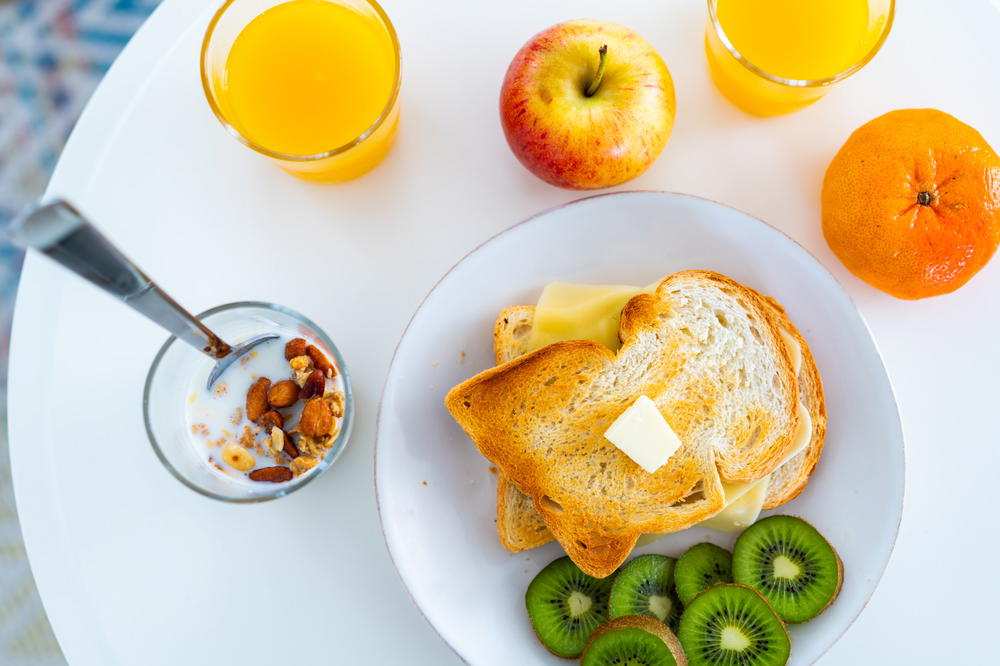
Tips for working from home start with how to work from home and stay healthy. You’ll love our remote work healthy eating plan for healthy habits while working from home.
This article may contain affiliate links. We earn a small commissions when you purchase via those links — and it's free for you. It's only us (Becca & Dan) working on this website, so we value your support! Read our privacy policy and learn more about us.
Table of contents
- Avoid sugary-heavy drinks by replacing them with seltzer, flavored water and tea.
- If you want to limit snacking when you work from home, do meal prep.
- Set a meal schedule for your work-from-home workday.
- Count calories to make sure you’re not overeating when you work from home.
- Try to only eat when you’re hungry and not because you need a break.
- Try to substitute any type of perishable snack for fresh food.
- Prep your snacks to save time while you’re working.
- Make sure your kitchen is an enjoyable place.
- Pre-portion dried staples like rice and pasta, according to serving size.
- Try to cook meals and save half.
- Always keep researching recipes.
- Save ordering food for special occasions, rather than defaulting to it.
- Get cooking inspiration from health-conscious videos and YouTube personalities.
- Don’t buy junk food.
- Be careful with calorie-dense foods like tahini, peanut butter and cheese.
- Put a limit on sugary and dried foods.
- Make cooking an enjoyable activity.
- If you don’t like the act of cooking, think of quick recipes that make it more enjoyable for you.
- Make sure that your kitchen has staples.
- Stock up on produce and healthy canned foods at your grocery store.
- Keep a stock of frozen fruit for when fruits are not necessarily in season.
- Make sure your eating space is a comfortable one.
- Prepackage your lunch and take it to a park.
- Stay hydrated.
- Avoid white sugar: it makes you feel lazy and can create headaches.
- Avoid too much salt and try not to add salt to foods that are already high-sodium.
- Limit the amount of olive oil or canola oil you use to cook.
- If you’re working from home with a partner, split up responsibilities.
Are you working from home and wondering what your next meal will be, and further, how to make sure it’s healthy?
Do you feel like working from home makes you default to unhealthy eating habits?
Or, are you looking for fresh tips for how to keep your eating healthy, to spice things up?
We had formed lots of good habits for healthy eating while we were traveling, and those stuck with us even after we returned home. Among these were a conscious effort to stay hydrated, shopping with an emphasis on local produce (fruits and vegetables) and cooking whenever possible.
Here’s what’s up: forgetting to choose healthy habits has become one of the most common mistakes when transitioning to working from home for the first time.
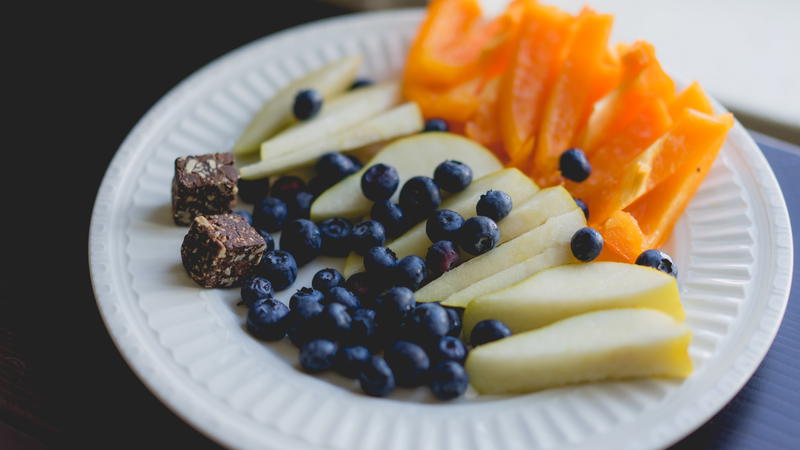
This may take a switch of a mindset, so to speak, but think of your healthy eating as contributing to and directly affecting your success as a remote worker. Food should make you feel great, instead of groggy.
As we’re working from home as a couple, our household is a balance of time in the home office and time in the kitchen.
When we’re not in the kitchen, we’re aiming to conquer all the ways we can eat healthy while working from home and eliminate any doubts about wellness in our diets.
Healthy eating combats illness, fatigue and other bad habits, which are all especially important when working from home. Could that be why health for work-from-home professionals is a work from home trend?
If you are learning how to work from home, juggling the new work from home schedule can be overwhelming if you are also figuring out how to stay healthy.
We want to support you with the following tips, which cover our main goals of healthy eating while working from home, including:
- How to eliminate junk food as snacks when you work from home
- How to portion meals and avoid overeating while working from home
- How to figure out how to “meal prep” as a remote worker
- How to pick foods that are both filling and make you feel good when you’re home and working


We like to pair fitness with healthy eating, and that’s why we made our remote worker fitness guide. Use both resources for the best possible fit and healthy work-from-home lifestyle.
Let’s begin. What do we do every day to stay healthy as remote workers?
Avoid sugary-heavy drinks by replacing them with seltzer, flavored water and tea.
One of the biggest Becca-Dan rules is “no sugary drinks at home.” For this reason, we own a very dependable Soda Stream.
The Soda Stream lets you take regular drinking water and turn it into a big bottle of carbonated water, or seltzer, as it’s called, regionally. If you want to make it feel like it came from a restaurant, squeeze in some fresh lime or lemon, or an assortment of crushed berries for some natural flavor.
In our home, we never — and I mean never! — buy sugary sodas or even bottled drinks with added white sugar. We don’t buy juices, and if we do choose to have some fruit juice, we avoid juice from concentrate (which has less fiber and nutrients).
As an all-day drink, I drink tea (no milk and no white sugar). For flavor, I’ll sometimes add a little bit of honey (I admit it’s sugar, but I don’t do it with every cup).
For all other things that you drink during the day, consider water your healthiest choice.
If you want to limit snacking when you work from home, do meal prep.
“Meal prep,” as it’s called, is a way to set up meals so that they’re within your control and not haphazardly put together because you’re short on time or ingredients.
If you would like to plan out your meals in a controlled manner for your workdays, set aside time on a Sunday night and start your meal prep the night before or the day before you’ll be back at work in your home office.
Set a meal schedule for your work-from-home workday.
When you work from home, your day may be slightly less dictated by routine than when you’re in the office, and everyone takes lunch breaks around the same time, and even leaves for the day around the same time.
If you’re worried about your schedule while working from home, make a meal schedule that coincides with your work schedule.
For instance, if you only want to eat three times a day, you could even schedule your meal breaks into your calendar. Or, if you’re staying connected all day when you work from home, have a coworker as an accountability buddy to make sure you’re staying on target.
Count calories to make sure you’re not overeating when you work from home.
Working from home makes it so that your fridge and your pantry are much closer to your ‘office,’ naturally. When your home office is within feet of the fridge and the cabinet, it’s hard to not open both, just to make sure they’re still full.
Everyone (or maybe this is an American thing?) likes to look into their fridge just to see what’s around…right?
If you want to count calories, and there’s no shame in this because it can teach you TONS about your diet, use an app like MyFitnessPal. It’s one of the apps we also include in our epic list of travel apps because keeping your diet in check when you’re travel is just as challenging.
Counting calories can open up a can of worms and can be tedious and challenging to continue to do long term. It’s a good idea to do it for a few days, at a minimum, to get a ballpark idea of what you’re eating each day.
You may find that some foods that you were eating had more calories than you thought. Sometimes a few handfuls of nuts can really add up throughout the day.
Try to only eat when you’re hungry and not because you need a break.
Taking a break from work, while you work at home, doesn’t necessarily mean you have to have a snack or a sweet drink or treat.
Take breaks to do things like clean the dishes or chores. Or, take a stretching break instead of eating.
One of our favorite work from home tips is to use stretching as a break. We recommend keeping a yoga mat by YOGO near your work area so that stretching seems inviting.
Try to substitute any type of perishable snack for fresh food.
Since we both started working from home, we try to load our pantry with nonperishable foods we can use in meals, and snacks that are fresh. We try to reserve the non-perishables for mealtime or days when we don’t have time to shop. Instead, we try to consume what’s in our refrigerator or fruit bowl.
Our favorite and go-to snacks are vegetables like baby carrots, baby tomatoes, and celery sticks. For fruit, we try to have a good supply of apples, oranges, clementines or mandarins, bananas, berries or pears.
For months when fresh produce isn’t as available, we like buying a variety of frozen fruits and vegetables. It requires a little bit more prep time, but making a fruit smoothie or roasting some vegetables is a great healthy alternative to processed foods.

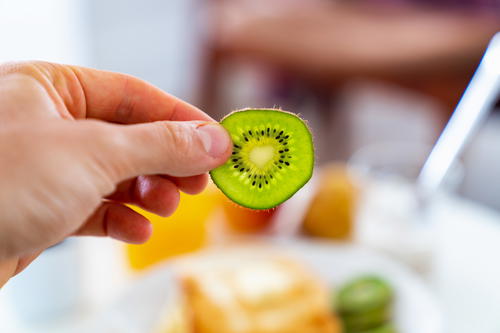
Prep your snacks to save time while you’re working.
If you’re pressed for time during your workday, soak and pre-cut your vegetable snacks. Soak or cut sticks of celery and carrots ahead of time, so that they’re easy to grab and don’t require peeling every time you want to eat them.
Also, if you like cilantro and dill as much as we do, pre-rinsing and storing them in the fridge in water is a great way to keep them fresh for longer.
Make sure your kitchen is an enjoyable place.
I used to live in a kitchen that I shared with roommates and it wasn’t somewhere I loved to be. This made me not want to cook. It was simple: the less I had a desire to be in the kitchen, the less I enjoyed making my own food. This is when I saw my health take a dip because I resorted to eating out and grabbing food on my way home from work.
Now, as we are both working from home, we make sure that our kitchen is a wonderful place to be. We recommend a few things for your kitchen to make it a place where you want to enjoy cooking and work toward your health as a remote worker:
- Make sure your kitchen is organized. You can even take some time on a weekend to do some organizing (we just did) so that your week is less stressful! Low stress helps you avoid burnout while working from home.
- Make sure spices are in plain sight so that you use them before you start salting your food.
- Place the kitchen items that you use often in front of others. Or, place the things you want to use (sharp knives, for example) often in more plain sight than things you don’t want to use.
- If you have a cluttered kitchen, put away things you don’t use often like blenders and food processors.
Overwhelmed with buying spices? Get a simple spice starter set to eliminate the stress of choosing, and then check out our guide to decluttering a kitchen in an apartment.
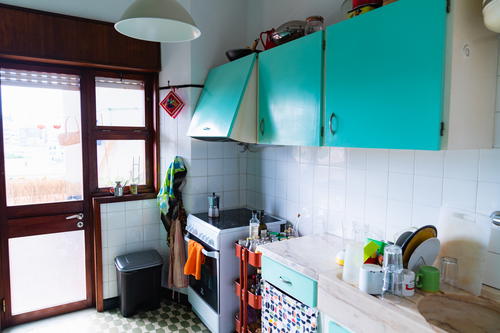
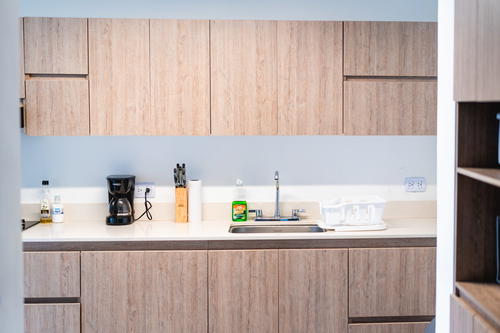
Pre-portion dried staples like rice and pasta, according to serving size.
This is so you don’t make too much. It’s easy to say you’ll make an entire cup of rice of quinoa so that you can put half of it away, but if you’re hungry, you may wind up eating the entire thing (and for quinoa, this is 4x a single serving).
You can also get food that comes pre-portioned, like macadamia nuts or other higher-calorie-per-serving snacks. Make sure to eat only one serving!
Try to cook meals and save half.
Cook meals for lunch that you can consume half of and save the other half for dinner, especially if you’re making more than you think you need. If you’re the type of person who wants to relax as soon as the workday is over, then you can head right into your virtual happy hour with coworkers, as a way to stay connected, and simply heat up the dinner that’s already pre-made.
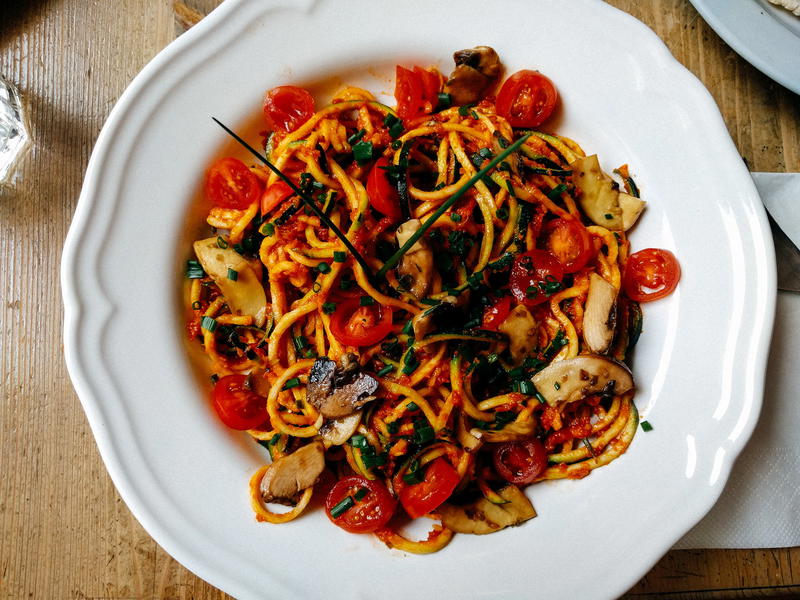
Always keep researching recipes.
We recommend that you start making recipe research a hobby. There’s something therapeutic about it (if you love to cook and find that cooking is relaxing).
There are so many beautiful cooking blogs out there that make cooking well seem like a goal you can work toward. We like Bon Appetit and recipes by Jamie Geller.
Save ordering food for special occasions, rather than defaulting to it.
While we were traveling full-time, we knew that if we didn’t set limits for ourselves, we would eat tacos in Mexico City and food from the markets of Taipei literally all the time.
So, what did we do? We made cooking a priority and ate out local food if we were out for the day. It’s not that we were trying to avoid the local cuisine — it’s more like we knew that too much of anything good was not ideal, especially when we were trying to focus on health.
Now, with working from home, we only order in food or go out for it if we’re completely out of groceries, if we’re socializing with friends or if we’re in the mood for date night.
Most of the time, though, our date nights are cooking at home together and then eating together.
We find that saving the takeout for special occasions, rather than giving into laziness after a workday, is great for our health (both mental and physical).
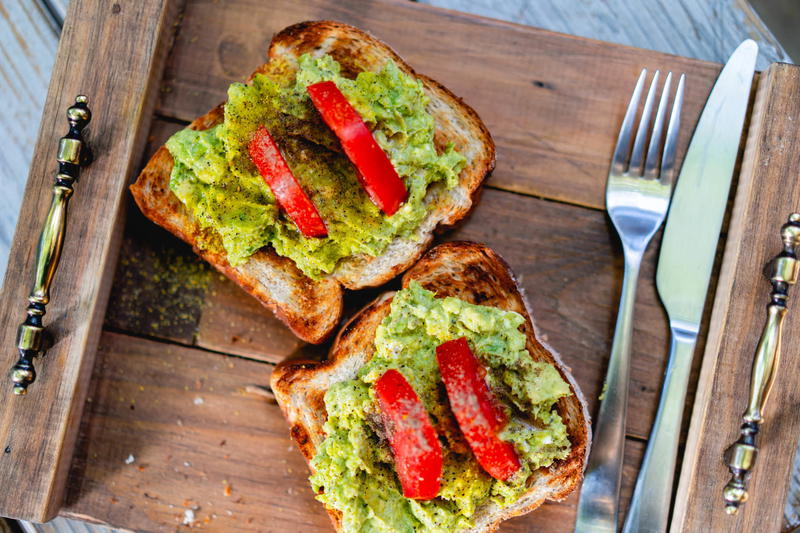
Get cooking inspiration from health-conscious videos and YouTube personalities.
We’ve blabbed quite a bit about how much we love to watch cooking videos, but it’s true — watching professional chefs keeps us goal-oriented with doing ‘better’ in the kitchen.
Recently, our favorite YouTube channels are Ethan Chlebowski and Joshua Weissman, but we’re always on the lookout for more inspiring chefs to follow so that the post-work routine stays unique every day when we’re home.
Don’t buy junk food.
This is so much easier said than done, but it starts with your grocery shopping.
If you don’t have junk in your house, you won’t be able to eat it. It’s simple!
When we go grocery shopping, we go through the produce section, the seeds and nuts section, the grains section (gluten-free pasta for Becca), the refrigerated dairy and eggs aisle and finally, the frozen section for our frozen fruits and vegetables (never any pre-made high-sodium meals - never ever!).
We skip the junk aisles. We don’t buy cookies, and we don’t even buy crackers! These are things we know are so delicious that we’d eat a whole box in a sitting (yikes), and so if we choose to not have them in our home, we know that we can’t go off the deep end by overdoing it.
Rarely, we’ll treat ourselves to something special like gluten free cookies for a birthday or a party that we’re hosting. It’s not normal for us and we try and treat these types of things like a reward!
Dan went to a picnic with some friends and brought home leftover cookies. For the next few days, after his run, he would have 1 of the cookies. It was extra motivation to get out and exercise.
Be careful with calorie-dense foods like tahini, peanut butter and cheese.
If you’re working from home and you want a quick breakfast, quick lunch or quick snack, you probably want to eat enough so that your mind is ready for your next task.
Our suggestion: limit consumption and question if you really need the high-calorie additions of nut butters, dairy and other spreads, in your diet.
Another tablespoon here and there of something like almond or cashew butter can clock in at several hundred calories, so beware, and give yourself limits — especially when you’re home alone working and no one is watching.
Put a limit on sugary and dried foods.
For both of us, we can eat mindlessly while working if any type of finger food is in a bowl next to our laptops. We are both huge snackers! The biggest dangers here are sugary and dried foods that add up quickly in sugars and in calories.
For example, the serving size of medjool dates is 4 dates, and these 4 small dates add up to 266 calories.
If you had a bowl of 12 dates next to you on your desk as you worked and if you ate all of them, that’s not only around 800 calories, but it’s nearly half of what most humans are suggested to consume, calorie-wise…in a whole day!
If you have a dried fruit problem, consider getting a properly-portioned date-based snack bar like the Rx bar, where eating only one will feel like plenty. It’s a way to get dried fruit for some sweetness, plus protein.
Be mindful when eating sugary or dried foods like dried fruit, and if you want to mindlessly snack, give yourself a bowl of carrots or vegetables to limit sugar and still pack in your fiber and nutrients.
Make cooking an enjoyable activity.
If you’ve just started cooking, or if you’re trying to like cooking, there are a few ways to do this!
First, cook with a partner. Cook with a spouse, a significant other, a child or a roommate. You can even cook while your dog or cat is keeping you company.
If you don’t have anyone to accompany you in your cooking, do your cooking while in the company of a great cooking video on YouTube.
You can even start a YouTube cooking playlist of all your favorite chefs so that you’re motivated and also learning, while you chop onions and saute your garlic.
If you’re new to cooking, we can honestly recommend that you get yourself a new set of knives and learn how to use them (watch videos!). Knives make all the difference in how ‘enjoyable’ your kitchen time will be.
If you don’t like the act of cooking, think of quick recipes that make it more enjoyable for you.
For us, we found that cooking videos provide great inspiration and we like recreating and experimenting creatively with ways we can use our normal pantry ingredients at home.
There are lots of foods that can be pretty “hands-off” if you don’t enjoy being in your kitchen or near it. For example, if you put some quinoa in a pot to cook, make use of a timer, whether on a smart speaker like an Echo Dot or Alexa or on your phone.
Make sure that your kitchen has staples.
Kitchen staples are those food items that are a good base for a meal, or the things that never really go out of style (or expire). Staples should be your versatile ingredients.
For us, we have plenty of rice, quinoa, pasta, olive oil, coconut oil and things we use often.
Make sure that you have enough of that to last you a few months, or buy in bulk. This way, you don’t have to do much thinking, or even much frequent shopping, if you have a busy week with work.
Getting a product like coconut oil spray will ensure that your supply lasts months and months. We use coconut oil spray in addition to solid coconut oil in a jar, and the spray seems to never run out.
Stock up on produce and healthy canned foods at your grocery store.
The base of all our healthy habits is lots of fresh produce and healthy items in cans. In fact, we don’t buy anything in a can that has much added salt. For example, we buy canned chickpeas, black beans and crushed tomatoes, and never any canned soups or canned chilies.
Keep a stock of frozen fruit for when fruits are not necessarily in season.
This is one of our favorite healthy work-from-home hacks and we want to tell you all about it. I was first introduced to ‘frozen mangoes’ as a treat by my college roommates. This might be a rather US-centric item to find in a supermarket, but we’re enjoying it now that we live in the US again.
We like eating frozen blueberries as a quick snack. Add maple syrup, coconut flakes or flax seeds to make it have texture. Or, throw an assortment of frozen fruit into a NutriBullet or Vitamix, and voila - you have a quick and healthy smoothie to sip on during your next meeting.
Make sure your eating space is a comfortable one.
Designate an eating space for eating so you can relate it to a lunch break from work. Do you really enjoy eating at your desk? Avoid the sad desk lunch!
Do you own some plastic food containers that you like, for taking prepped food on the go? We can recommend a set of Rubbermaid containers for every size of leftover food, whether a slice of fruit or a big meal.
Prepackage your lunch and take it to a park.
It’s true — and we hope you’ll agree — that eating outside can give a break to the normal work day in both a physical and mental way. If you have some outdoor space at your disposal, take
Take a snack with you and take a walk in the early afternoon for a break.
Nuts will work!
When you get hungry, instead of going to the kitchen, go for a quick walk and grab some water.
Tell yourself you have to drink an entire bottle of water or seltzer water during the walk.
Stay hydrated.
Water, water, water. It’s easy to forget to drink water. If you don’t like drinking plain water, might we suggest seltzer water with the Soda Stream we mentioned above, or decaffeinated tea? Both are a great way to get hydration without the added sugar or sodium.

Even if we’re home, we wind up drinking out of our reusable water bottles and we recommend always having one nearby!
Avoid white sugar: it makes you feel lazy and can create headaches.
I found out when I was around 25 years old that sugar gives me uncomfortable headaches. I was in the Starbucks below my office and had ordered an almond milk mocha latte to “treat myself” (note: this is not what ‘self-care’ looks like!) and immediately regretted it.
Our top tip is to keep sugar out of the house. While the average household has a jar or a box of white Domino sugar, we choose to have…none! Our sweeteners of choice are maple syrup or raw honey, and this is how we keep white sugar out of most things we consume under our roof.
Keeping white sugar out of your work day will help you focus better and can help you avoid headaches while on the job.
Maple syrup is a type of naturally-occurring sweetener we find that we use all the time, and it’s worth having it in a large-size so that you don’t have to go through containers of it frequently.
Avoid too much salt and try not to add salt to foods that are already high-sodium.
Salt is tough, but I started limiting salt in my mid-twenties when I became more health-conscious.
Our tip is to reserve salt for food that needs a little boost, like grains that otherwise have no flavor. Of course, we recommend seasoning with non-salt spices and seasonings first, and adding salt if it needs a little more of a kick.
Add hot sauce instead of salt. It packs a punch! We like Cholula hot sauce.
Limit the amount of olive oil or canola oil you use to cook.
One thing we’ve learned about oil is that you can always get by with much less. Restaurant foods are liberal with oil and salt. If you’re choosing to cook it home, it means you are in control.
The more oil you use, the more salt you’ll need, to neutralize. Avoid both and lower both in the foods you cook at home during the work day, or afterward.
Using olive oil in a spray can might help how much you’re using.
If you’re working from home with a partner, split up responsibilities.
When we’re working from home as a couple, we have post-work responsibilities.
One of us cooks and the other one cleans. This makes our routine feel efficient and optimal, and we still get to enjoy post-work time together, always.
You may also like
-
![]()
22 Tips for Staying Fit When Working Remotely (It Worked for Us)
Should work-at-home fitness be a challenge? All remote workers want to know how to stay active when working from home. Here are our tips for a work-from-home exercise routine.
-
![]()
How to Stay Connected While Working Remotely
Figuring out how to stay connected while working from home? Connecting with your coworkers when you work remotely and connecting remote teams is easy!
-
![Exposed brick wall in a living room with a home office desk, silver laptop on a black laptop stand, white wireless keyboard, wireless mouse and black bluetooth head phones]()
How to Set Up a Home Office in a Small Apartment
Need ideas for a small cozy home office? Here's our best tips for creating a home office in a living room, or how to make a home office in a small space, small room or small apartment.
-
![]()
How to Create a Daily Work-from-Home Schedule
Adjusting to working from home, and thinking about a work from home schedule template? We're sharing how to create a home schedule, with tips for working from home effectively.
-
![Flat lay of a home office setup with clear glasses, a white cup full of coffee, leafy green plants and a black keyboard]()
How to Prevent Work from Home Burnout
Let’s talk about how to avoid burnout while working from home or working remotely. With these tips for working remotely from home, we share how tips for productivity and staying positive.
-
![Woman using Dell XPS on a team table outside at a cafe]()
15 Ways to Network Remotely When You Work From Home
How can you build your network virtually? See tips for networking in a remote work environment, remote work communities, and ways to expand your network when working at home.











